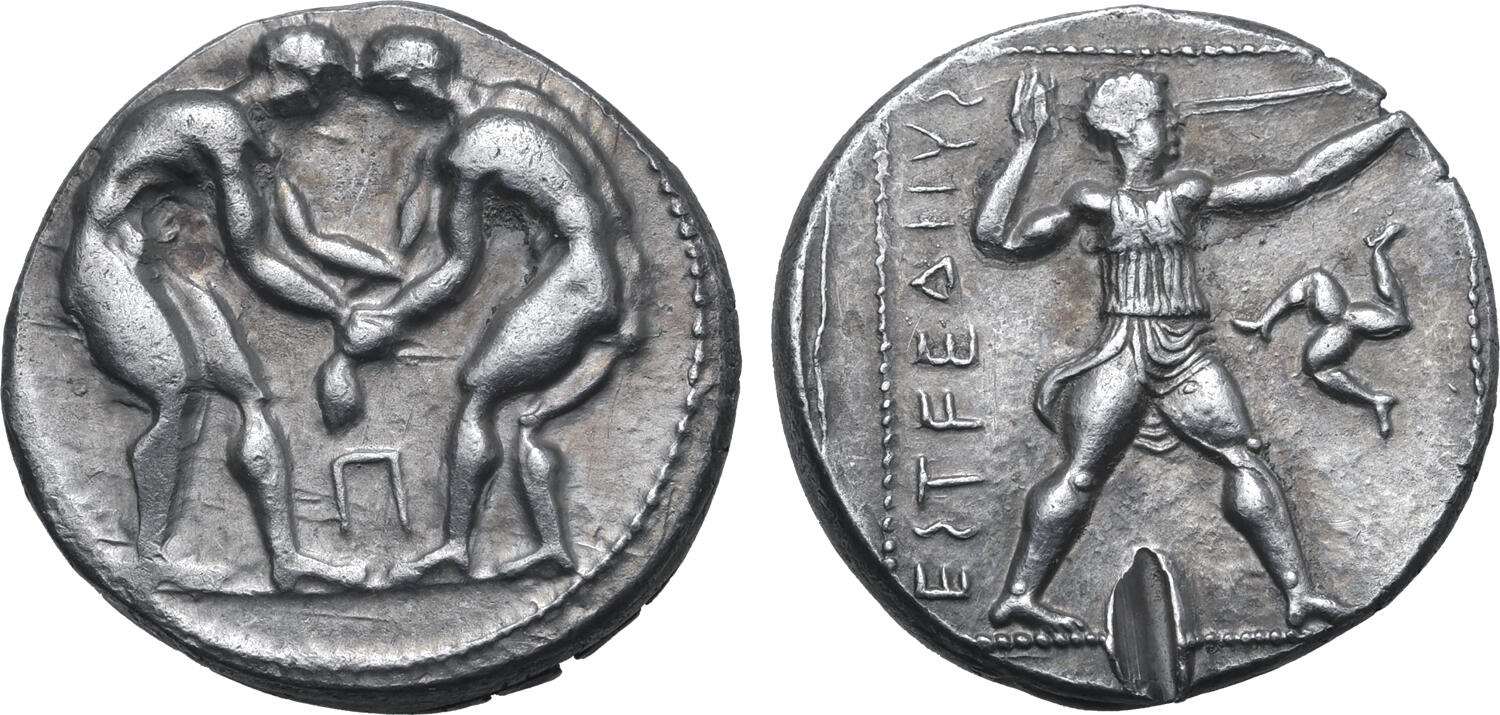361 BCE - 334 BCEB'LTRZ (Aramaic characters) | MZDI (in Aramaic characters)
Overstruck variety
Aspendos.jpg
|
|
Sale(s)Sale(s) ᵖ:
|
Classical Numismatic Group, EA 373, 20 Apr. 2016, 160
|
| Private collection(s)Private collection(s) ᵖ:
|
Byron Schieber collection
|
|
Description
| ObverseInscription or printing placed on the obverse.:
|
B'LTRZ (Aramaic characters) (Aramaic) Baaltars seated left, holding eagle, grain ear, grapes, and scepter. Border of dots.
|
ReverseInscription or printing placed on the reverse.:
|
MZDI (in Aramaic characters) (Aramaic) Lion attacking bull left. Border of dots.
|
Mint and issuing power
Chronology
| FromIdentifies the initial date in a range assigned in a numismatic context. 361 BCE toIdentifies the final date in a range assigned in a numismatic context.. 334 BCE
|
Classical 480-323 BC  periodTime period of the numismatic object. periodTime period of the numismatic object.
|
Physical description
MetalThe physical material (usually metal) from which an object is made.: Silver 
|
WeightWeight of the numismatic object (in grams). in grams: 10.6510.65 g <br />10,650 mg <br />
|
DenominationTerm indicating the value of a numismatic object. Examples: tetradrachm, chalkous, denarius.: double siglos 
|
AxisDescribes the directional relationship between the obverse and reverse of a numismatic object.: 22 mm <br />0.2 cm <br />
|
| DiameterDescribes diameter of an object (in mm).: 2424 mm <br />2.4 cm <br />
|
StandardStandard.: Persian
|
References
Description
| ObverseInscription or printing placed on the obverse.:
|
Wrestlers.
|
ReverseInscription or printing placed on the reverse.:
|
slinger (visible on obverse: last two letters of ethnic and edge of dotted square border)
|
Mint and issuing power
Chronology
| FromIdentifies the initial date in a range assigned in a numismatic context. 420 BCE toIdentifies the final date in a range assigned in a numismatic context.. 360 BCE
|
Classical 480-323 BC  periodTime period of the numismatic object. periodTime period of the numismatic object.
|
Physical description
| DenominationTerm indicating the value of a numismatic object. Examples: tetradrachm, chalkous, denarius. ᵖ:
|
double siglos 
|
StandardStandard. ᵖ:
|
Persian
|
References
| Frequency of overstrikesFrequency of overstrikes:
|
rare and spread
|
Level of confidenceLevel of confidence of the identification:
|
sure
|
| RemarksRemarks:
|
"Overstruck on a stater of Aspendos; last two letters of ethnic and edge of dotted square border visible on obverse"
|
References
- ^ Levante, Edoardo (1993), Sylloge nummorum graecorum. France 3. Cabinet des Médailles : Cilicie, Paris, BnF, xviii + 274 p., 103 pl.
- ^ Callataÿ, François de (2018), “Overstrikes on Pamphylian and Cilician silver sigloi (5th-4th c. BC)”, in O. Tekin (ed.), Proceedings of the Second International Congress of the Anatolian Monetary History and Numismatics in the Mediterranean World, 5-8 January 2017 Antalya, Antalya, 2018, p. 131-150.
- ^ Breitenstein, Niels (1955), Sylloge Nummorum Graecorum: Royal Collections of coins and medals. Danish National Museum, 31, Lycia-Pamphylia.
- ^ Tekin, Oguz (2000), "Aspendian 'Wrestlers' : an iconographic approach", in: Casabonne, Olivier (ed), Mecanismes et innovations monetaires dans l'Anatolie achemenide : numismatique et histoire : actes de la table ronde internationale d'Istanbul, 22-23 mai 1997, Paris, Institut français d'etudes antoliennes d'Istanbul, p.159-169, pl. 27-28


